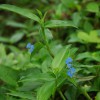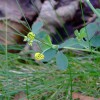 Violets (Viola spp.) are diverse winter annuals and perennials. Perennials form rhizomes or long stolons. Many have heart-shaped leaves on long petioles and have a rosette growth habit. Some have linear leaves and others have palmate leaves. Flowers are generally purple, but can be white, pink or yellow. They reproduce by seed or, when produced, rhizomes. This 2-page fact sheet was written by Darcy E. P. Telenko, Barry J. Brecke, Ramon Leon, and J. Bryan Unruh, and published by the UF Department of Environmental Horticulture, December 2013.
Violets (Viola spp.) are diverse winter annuals and perennials. Perennials form rhizomes or long stolons. Many have heart-shaped leaves on long petioles and have a rosette growth habit. Some have linear leaves and others have palmate leaves. Flowers are generally purple, but can be white, pink or yellow. They reproduce by seed or, when produced, rhizomes. This 2-page fact sheet was written by Darcy E. P. Telenko, Barry J. Brecke, Ramon Leon, and J. Bryan Unruh, and published by the UF Department of Environmental Horticulture, December 2013.
http://edis.ifas.ufl.edu/ep496
Tag: Weed Biology and Management in Turf series
Spreading Dayflower Biology and Management in Turf
 Spreading dayflower (Commelina diffusa) is a succulent annual that produces freely branched smooth stems. Leaves are broadly lance-shaped with closed sheaths. Sheaths are short with a few soft hairs on the upper margin. Flowers have three blue petals in a leaf-like structure open on the margins. Reproduction occurs via seed and stem fragments. This 2-page fact sheet was written by J. Bryan Unruh, Darcy E. P. Telenko, Barry J. Brecke, and Ramon Leon, and published by the UF Department of Environmental Horticulture, December 2013.
Spreading dayflower (Commelina diffusa) is a succulent annual that produces freely branched smooth stems. Leaves are broadly lance-shaped with closed sheaths. Sheaths are short with a few soft hairs on the upper margin. Flowers have three blue petals in a leaf-like structure open on the margins. Reproduction occurs via seed and stem fragments. This 2-page fact sheet was written by J. Bryan Unruh, Darcy E. P. Telenko, Barry J. Brecke, and Ramon Leon, and published by the UF Department of Environmental Horticulture, December 2013.
http://edis.ifas.ufl.edu/ep497
Black Medic Biology and Management in Turf
 Black medic (Medicago lupulina) is a dark green annual with spreading, prostrate growth. Leaves are alternate with three leaflets on square stems. Leaflets are obovate to elliptic, toothed near the tip, and have a small spur on the tip. Bright yellow flowers are produced in tight, compressed clusters at leaf axils. Reproduction occurs via seed in tightly coiled black seed pods. This 2-page fact sheet was written by Barry J. Brecke, Ramon Leon, J. Bryan Unruh, and Darcy E. P. Telenko, and published by the UF Department of Environmental Horticulture, December 2014.
Black medic (Medicago lupulina) is a dark green annual with spreading, prostrate growth. Leaves are alternate with three leaflets on square stems. Leaflets are obovate to elliptic, toothed near the tip, and have a small spur on the tip. Bright yellow flowers are produced in tight, compressed clusters at leaf axils. Reproduction occurs via seed in tightly coiled black seed pods. This 2-page fact sheet was written by Barry J. Brecke, Ramon Leon, J. Bryan Unruh, and Darcy E. P. Telenko, and published by the UF Department of Environmental Horticulture, December 2014.
http://edis.ifas.ufl.edu/ep494
Sedge Biology and Management in Turf
 Members of the sedge family have leaves that are composed of a blade, sheath, and ligule. The leaf sheath is closed and the ligule is often absent, and when present is tiny. Stem structure is often triangular.This 3-page fact sheet was written by D. E. P. Telenko, Ramon Leon, J. Bryan Unruh, and B. J. Brecke, and published by the UF Department of Environmental Horticulture, December 2014.
Members of the sedge family have leaves that are composed of a blade, sheath, and ligule. The leaf sheath is closed and the ligule is often absent, and when present is tiny. Stem structure is often triangular.This 3-page fact sheet was written by D. E. P. Telenko, Ramon Leon, J. Bryan Unruh, and B. J. Brecke, and published by the UF Department of Environmental Horticulture, December 2014.
http://edis.ifas.ufl.edu/ep492
Old World Diamond-Flower Biology and Management in Turf
 Old world diamond-flower is a smooth, spreading summer annual. It has branched stems with opposite, narrow leaves. Flowers are white, usually with two or more on long stalks extending from the tip of a common long stalk. Flowers occur from midsummer until frost. Reproduction occurs by seed. Found in moist areas, especially areas that have been disturbed. This 2-page fact sheet was written by Darcy E. P. Telenko, Barry J. Brecke, Ramon Leon, and J. Bryan Unruh, and published by the UF Department of Environmental Horticulture, December 2013.
Old world diamond-flower is a smooth, spreading summer annual. It has branched stems with opposite, narrow leaves. Flowers are white, usually with two or more on long stalks extending from the tip of a common long stalk. Flowers occur from midsummer until frost. Reproduction occurs by seed. Found in moist areas, especially areas that have been disturbed. This 2-page fact sheet was written by Darcy E. P. Telenko, Barry J. Brecke, Ramon Leon, and J. Bryan Unruh, and published by the UF Department of Environmental Horticulture, December 2013.
http://edis.ifas.ufl.edu/ep493